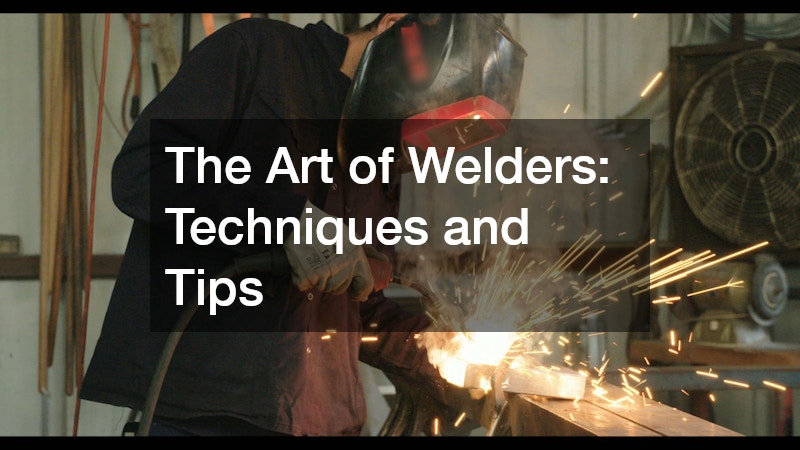Welding is far more than a technical trade—it is an art form that combines precision, knowledge and craftsmanship. Whether you’re observing the steady hand of a fabricator assembling intricate steel frames or admiring the clean, fluid lines of a professional joint, it’s easy to recognise the artistry behind the work of skilled welders. In modern construction, manufacturing and even creative industries, welders play a crucial role.
Their expertise can mean the difference between structural integrity and failure, between rough seams and seamless beauty. This article explores the artistry of welding, detailing proven techniques and sharing tips that distinguish professionals in this demanding and dynamic field.
Understanding the Craft
At the heart of welding lies the principle of joining materials—most commonly metals—through high heat, with or without the use of filler material. But this simplistic definition does little justice to the depth and range of skills involved. Welding techniques vary depending on the type of metal, the environment and the desired outcome. Methods such as Gas Metal Arc Welding (GMAW), Tungsten Inert Gas Welding (TIG) and Shielded Metal Arc Welding (SMAW) each require specialised training and hands-on experience.
Every professional welder starts with the basics: understanding metal properties, reading technical drawings, mastering safety standards and learning to control temperature and weld speed. Yet, as skills develop, welders begin to imbue their work with a unique style—whether it’s the appearance of the bead, the confidence in movement or the ability to adapt to complex challenges on the fly. This transformation from technician to artisan is what sets apart the very best in the field.
Key Techniques That Define Excellence
Mastery in welding involves a combination of science and finesse. The choice of technique significantly impacts the quality of the final product. For instance, TIG welding, often used for stainless steel or aluminium, demands patience and a steady hand. It produces clean, precise welds ideal for decorative work or structurally sensitive applications. Meanwhile, MIG welding offers speed and efficiency, making it popular for high-volume manufacturing. Stick welding, on the other hand, is valued for its versatility and performance in outdoor or rugged environments.
Beyond selecting the appropriate technique, achieving excellence in welding also requires a deep understanding of joint preparation and positioning. Cleaning the metal thoroughly before welding, selecting the right electrode or filler and ensuring accurate alignment are foundational steps. Equally critical is the control of heat input. Too much heat can lead to warping or burn-through, while too little may result in weak bonds.
Angle, speed and consistency are also essential variables. Welders must maintain a consistent travel speed and angle to ensure uniformity in their beads. Even slight deviations can affect penetration and appearance. Professional welders often practice on scrap materials before tackling the final piece to perfect these details and avoid costly mistakes.
Tips to Enhance Skill & Precision
One of the most important tips for aspiring welders is to never stop learning. Welding is a field where techniques evolve and new materials or tools constantly enter the market. Staying informed through industry publications, formal training and mentorship opportunities can make a significant difference.
Investing in high-quality equipment also matters. While experience is vital, the right tools can enhance precision and reduce errors. From auto-darkening helmets that protect the eyes and improve visibility to inverter-based machines that offer better control and energy efficiency, technology can elevate the quality of work.
Attention to ergonomics and comfort is often underestimated. Welding can be physically demanding and poor posture or inadequate protective gear can lead to fatigue and mistakes. Professional welders often design their workspaces for efficiency and safety, including good lighting, ventilation and adjustable work surfaces.
Lastly, patience and focus cannot be overstated. Rushing a weld rarely yields good results. Whether working on a pressure pipe or a sculpture, taking the time to prepare, align and execute each pass with care leads to better outcomes. Many experienced welders say that achieving flow—the mental state where movement feels effortless and time passes unnoticed—is one of the greatest rewards of the trade.
Honouring the Artisan Behind the Arc
The art of welders is built on a foundation of technical mastery, continuous learning and an eye for detail. While the spark of a welder’s torch may seem industrial to the untrained eye, those in the know understand that this is where form meets function and skill meets creativity. Every bead laid, every joint fused, tells a story of precision, control and dedication to craft.
Welders are integral to countless industries, from shipbuilding and automotive manufacturing to aerospace and fine art. As demands on metal structures grow more complex, so too must the capabilities of those who shape and bind them. Understanding the techniques and tips that define quality workmanship is not only essential for newcomers but also a source of continuous refinement for seasoned professionals.
Ultimately, the best welders do not merely join pieces of metal—they create strong, lasting connections that support bridges, buildings, machinery and more. In doing so, they embody a unique blend of science, skill and artistry that deserves both recognition and respect.
.

